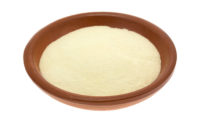Reformulation by popular demand
Replacing ingredients like nitrites and phosphates takes planning to avoid inferior or cost-prohibitive products.

The importance of healthy eating is a long-standing trend that accelerated during the pandemic. More than ever, food labels are where purchases are won or lost. The presence of too many ingredients perceived as “unnatural” might be a good enough reason for consumers to leave a product on the shelf.
Meat processors are responding to this demand by reducing or removing ingredients that are perceived as potentially unhealthy. The worst offenders in the eyes of consumers are nitrites, phosphates, MSG, salt, fat, and chemical-sounding names like butylated hydroxytoluene.
These ingredients, however, are crucial for the taste and shelf stability of meat products, which can make the quest for suitable replacements quite challenging.
Successful reformulations require careful research and planning at three different levels.
“First of all, processors need to understand all the functions of the ingredient they're looking to reduce,” says Dr. Joseph G. Sebranek, Distinguished Professor of Animal Science at the College of Agriculture and Life Sciences of Iowa State University. “Phosphate is a great example: it helps bind water, increases tenderness and juiciness, and can even prevent microbial growth. The meat industry has a lot of support from suppliers developing products, like natural extracts, that are more acceptable to consumers and provide some of the functions of the original compound. However, in some cases, it's going to take more than one alternative ingredient to provide all those functions.”
“Once they have a substitute,” continues Sebranek, “they need to make sure that it won’t have a major impact on the product, or at least that the change is going to be acceptable to consumers.”
Consumers’ acceptance is indeed the second major aspect to consider. Although the clean label trend is a reality, it won’t affect all products in equal measure.
Before embarking on a reformulation project, processors need to answer important questions: what products are perceived as suitable for healthier reformulations? What ingredients are consumers particularly concerned with? Is it enough to simply reduce the content of an ingredient (like with salt), or would it be better to replace it completely? Are consumers open to tradeoffs in terms of texture, taste, and price?
While a lot of useful quantitative data can come from market research, it’s equally important to listen to the feedback from the field. “Retailers, hotel management, or whoever the customer base may be, are the direct interface with the consumers,” says Sebranek. “It’s important to listen to their feedback, even if it won’t be of a specific numerical value. Phosphates, for example, have been getting a lot of attention recently. There's a lot of concern from retailers because of the feedback they get from consumers.”
Launching a product that doesn’t meet consumers’ expectations is not just a problem for the brand, but for the whole product category. “During the previous wave of salt reduction between the end of the 1990s and the early 2000s, a lot of processors launched low-salt products without fully assessing the impact of their changes,” says Sebranek. “As it turned out, consumers didn't like them and started moving away from reduced salt products. That really hurt the other attempts to make products that would be more acceptable to consumers.”
Lastly, processors will need to consider costs and how much consumers are willing to spend. Classic additives of processed meat products have been used for a long time because they are cheap, accessible, effective, and don’t require further development. Any substitute is likely to cost more and may not have the same cooking yield. “Cost is the ultimate issue in a reformulation project,” says Sebranek. “You simply can’t make the product too expensive, regardless of how good it might be.”
Looking for a reprint of this article?
From high-res PDFs to custom plaques, order your copy today!






